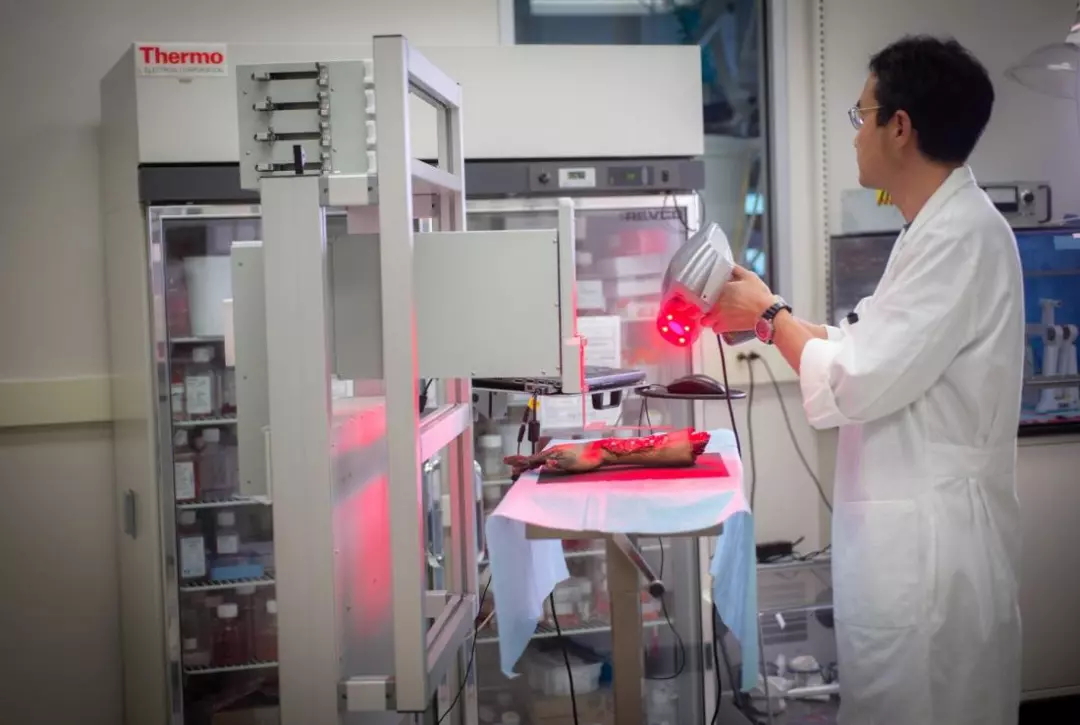Mimicking autologous transplantation, the first bioprinter to "print" double-layer skin directly on the wound
2019-03-28 14:09:18
Imagine a day in the future when a bioprinter filled with a patient's own cells moves back and forth beside the patient's bed, helping the patient heal large wounds or burns layer by layer by "printing skin". It may sound a bit sci-fi, but in fact we are not far away from this day.
Scientists at the Wake Forest Institute for Regenerative Medicine (WFIRM) in Winston-Salem, North Carolina, have invented a skin bioprinting system that uses the body's own skin cells to create new skin layers and apply them directly to the wound to help repair large wounds that usually require skin grafts.
This is the first bioprinter of its kind that can "print" a double layer of skin (keratinocytes and fibroblasts) directly onto the wound, which will make it possible to use bioprinters to "print skin layers" to help treat chronic wounds or burns.
While the advent of 3D printers is generally considered a revolution in manufacturing, it may also bring huge benefits to medicine. The idea of 3D printing skin has been in development for several years, with the first prototype in 2014, which could print large sheets of human skin, which could then be cut into the right size and transplanted into patients. Today, the technology has gradually developed into more sophisticated machines and eventually a handheld device that works like a tape dispenser for skin.

Figure | Bioprinter at work
The new machine invented by scientists at WFIRM looks like something in between. It's much larger than a handheld device, but still relatively portable in a hospital setting. The machine can be wheeled to the bedside and the patient can lie under the printer nozzle, which provides good conditions for patients to receive treatment for a long time.
Like previous 3D-printed skin devices, the new printer uses an "ink" made of the patient's own cells, which can minimize the risk of rejection.
During the entire repair process, the researchers first used the new machine to biopsy healthy skin and isolate two types of skin cells from it: fibroblasts, which help build structures to heal wounds, and keratinocytes, the outermost layer of the skin. The biopsy sample is then multiplied into a larger number of cells, and the machine mixes them into a hydrogel to form the "ink" of the bioprinter, which is the "raw material" for repairing wounds.
The difference between the new skin printer and previous ones is that the new machine does not just apply new skin to the wound, but first uses a 3D laser scanner to scan the patient's wound to build a wound topology map, and then inputs the data into the software and tells the device where to put the printed skin layer. Using this image, the device fills the deepest part with the generated fibroblasts, and then builds tissue formed by keratinocytes in the upper layer of the wound.

Figure | Conceptual diagram of the bioprinter
The skin is the largest organ in the human body. It protects various tissues and organs in the body from various external stimuli and is a very important natural barrier for the human body. Some people suffer skin trauma in disasters such as explosions, car accidents, and fires. Chronic trauma such as diabetes, venous ulcers, pressure sores, and burns are also a burden for patients and surgeons, affecting more than 7 million patients in the United States, with annual treatment expenses of up to $25 billion.
For military personnel, burns account for 10% to 30% of combat casualties in conventional wars. It is particularly expensive to treat some chronic, large, or non-healing wounds because they often require multiple treatments. For example, it costs about $50,000 to treat a diabetic foot ulcer.
There are many ways for medical staff to heal chronic wounds, such as using wound dressings, which are one of them and are relatively common, but their prices and effectiveness vary. For large chronic wounds and burns, skin transplants are also an option, but skin transplants are divided into autologous transplants and allogeneic skin transplants.
Researchers point out that skin transplants are common, but they also have many disadvantages. Autologous transplants refer to transplanting part of the patient's own skin to the wound site, but autologous transplants are difficult to perform due to the lack of healthy tissue, and allogeneic skin transplants have the risk of tissue rejection. The new bioprinting technology will help improve these risks because it allows skin to grow outward from the center of the wound, an advantage that only exists in autologous transplants.
This technology accelerates the rate of wound healing by mimicking the natural structure of skin cells. The researchers used a mouse model to prove the effectiveness of this method, and they observed that new skin began to form from the center of the wound outward. The most noteworthy point is that the "ink" material used in this new device is unique and is cultured and propagated from the patient's own cells, which does not require donor skin transplants, avoids the occurrence of transplant rejection, and has less risk.
Dr. James Yoo, who led the research team, explained that the new biological skin printing can make wounds start to heal faster. He said that other treatments cannot really create skin like biological printers.
The researchers said that the next step is to conduct human clinical trials. Ultimately, this new device may help some burn patients, diabetic ulcer patients and other patients with large wounds that are difficult to heal on their own for safe and quick treatment.



